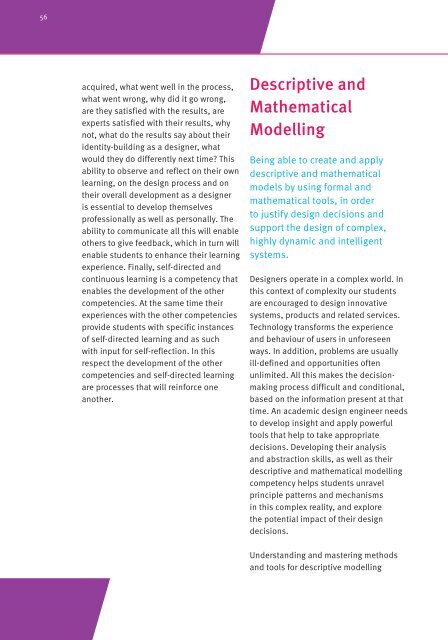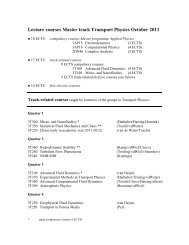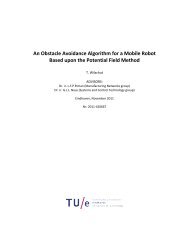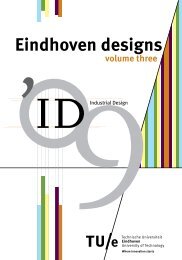Education guide 'Eindhoven designs' - Technische Universiteit ...
Education guide 'Eindhoven designs' - Technische Universiteit ...
Education guide 'Eindhoven designs' - Technische Universiteit ...
You also want an ePaper? Increase the reach of your titles
YUMPU automatically turns print PDFs into web optimized ePapers that Google loves.
56<br />
acquired, what went well in the process,<br />
what went wrong, why did it go wrong,<br />
are they satisfied with the results, are<br />
experts satisfied with their results, why<br />
not, what do the results say about their<br />
identity-building as a designer, what<br />
would they do differently next time? This<br />
ability to observe and reflect on their own<br />
learning, on the design process and on<br />
their overall development as a designer<br />
is essential to develop themselves<br />
professionally as well as personally. The<br />
ability to communicate all this will enable<br />
others to give feedback, which in turn will<br />
enable students to enhance their learning<br />
experience. Finally, self-directed and<br />
continuous learning is a competency that<br />
enables the development of the other<br />
competencies. At the same time their<br />
experiences with the other competencies<br />
provide students with specific instances<br />
of self-directed learning and as such<br />
with input for self-reflection. In this<br />
respect the development of the other<br />
competencies and self-directed learning<br />
are processes that will reinforce one<br />
another.<br />
Descriptive and<br />
Mathematical<br />
Modelling<br />
Being able to create and apply<br />
descriptive and mathematical<br />
models by using formal and<br />
mathematical tools, in order<br />
to justify design decisions and<br />
support the design of complex,<br />
highly dynamic and intelligent<br />
systems.<br />
Designers operate in a complex world. In<br />
this context of complexity our students<br />
are encouraged to design innovative<br />
systems, products and related services.<br />
Technology transforms the experience<br />
and behaviour of users in unforeseen<br />
ways. In addition, problems are usually<br />
ill-defined and opportunities often<br />
unlimited. All this makes the decisionmaking<br />
process difficult and conditional,<br />
based on the information present at that<br />
time. An academic design engineer needs<br />
to develop insight and apply powerful<br />
tools that help to take appropriate<br />
decisions. Developing their analysis<br />
and abstraction skills, as well as their<br />
descriptive and mathematical modelling<br />
competency helps students unravel<br />
principle patterns and mechanisms<br />
in this complex reality, and explore<br />
the potential impact of their design<br />
decisions.<br />
Understanding and mastering methods<br />
and tools for descriptive modelling

















